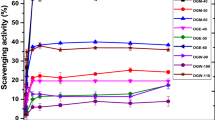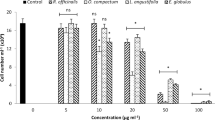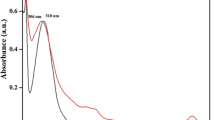Abstract
Burdock (Arctium lappa L.) extracts were prepared with different extraction methods, ethanol (70%, RT) and hot water (85°C for 3 hr, HT), and their biological activities were investigated after γ-irradiation (10 and 20 kGy). Color of the burdock extracts became brighter after application of irradiation regardless of the extraction system. The 1,1-diphenyl-2-picrylhydrazyl (DPPH) radical scavenging activity of the burdock extracts with RT and HT were 54.56 and 59.21% at 500 ppm, respectively, and the lipid oxidation of oil emulsion was delayed by addition of the extracts. The HT29 cancer cell viability was inhibited by burdock extracts with RT up to 52.45 at a 250 ppm level. The anti-mutagenicitiy against 3-amino-1,4-dimethyl-5H-pyrido[4,3-b]indole and 2-nitrofluorene were also found. Results indicate that burdock extract possesses biological activities and RT showed an increasing trend in antixodiative activity and inhibition of cancer cell viability. Brighter color of the burdock extract after irradiation may improve industrial applicability.
Similar content being viewed by others
References
Sovrano S, Buiatti S, Anese M. Influence of malt browning degree on lipoxygenase activity. Food Chem. 99: 711–717 (2006)
Chen FA, Wu AB, Chen CY. The influence of different treatments on the free radical scavenging activity of burdock and variations of its active components. Food Chem. 86: 479–484 (2004)
Kim MJ, Choe EO. Effects of burdock (Arctium lappa L.) extracts on autoxidation and thermal oxidation of lard. Food Sci. Biotechnol. 13: 460–466 (2004)
Han CM. Cultivation management of burdock in Kao-ping area. Agric. World 145: 55–57 (1995)
Morita K, Nishijima Y, Kada T. A desmutagenic factor isolated form burdock (Arctium lappa Linne). Mutat. Res. 129: 25–31 (1984)
Lin SC, Lin CH, Lin CC, Lin YH, Chen CF, Chen IC, Wang LY. Hepatoprotective effects of Artium lappa Linne on liver injuries induced by chronic ethanol consumption and potentiated by carbon tetrachloride. J. Biomed. Sci. 9: 401–409 (2002)
Lin CC, Lin JM, Yang JJ, Chuang SC, Ujiie T. Anti-inflammatory and radical scavenging effect of Articum lappa. Am. J. Chinese Med. 24: 127–137 (1996)
Alothman M, Rajeev B, Karin AA. Antioxidant capacity and phenolic content of selected tropical fruits from Malaysia, extracted with different solvents. Food Chem. 115: 785–789 (2009)
Marete EN, Jacquier JC, O’Riordan D. Effects of extraction temperature on the phenolic and parthenolide contents, and colour of aqueous feverfew (Tanacetum parthenium) extracts. Food Chem. 117: 226–231 (2009)
Ahn HJ, Kim JH, Kim JK, Kim DH, Yook HS, Byun MW. Combined effects of irradiation and modified atmosphere packaging on minimally processed Chinese cabbage (Brassica rapa L.). Food Chem. 89: 589–597 (2005)
Kim JH, Kim DH, Ahn HJ, Park HJ, Byun MW. Reduction of the biogenic amine contents in low salt-fermented soybean paste by gamma irradiation. Food Control 16: 43–49 (2005)
Jo C, Son JH, Lee HJ, Byun MW. Irradiation effect on color and functional properties of persimmon (Diospyros kaki L. folium) leaf extract and licorice (Glycyrrhiza uralensis Fischer) root extract during storage. Radiat. Phys. Chem. 67: 143–148 (2003)
Jo C, Son JH, Lee HJ, Byun MW. Irradiation application for color removal and purification of green tea leaves extract. Radiat. Phys. Chem. 66: 179–184 (2003)
Lee JW, Soe JH, Kim JH, Lee SY, Park JW, Byun MW. Reduction of the IgE-binding ability and maintenance of immunogenicity of gamma-irradiated Dermatophagoides farina. Radiat. Phys. Chem. 76: 1895–1898 (2007)
Yu L, Haley S, Perret J, Harris M. Comparison of wheat flours grown at different locations for their antioxidant properties. Food Chem. 86: 11–16 (2004)
Blois MS. Antioxidant determination by the use of a stable free radical. Nature 181: 1190–1200 (1958)
Carmichael J, Degraff WG, Gazdar AF, Minna J, Michell JB. Evaluation of a tetrazolium-based semiautomated colorimetric assay, assessment of chemosensitivity testing. Cancer Res. 47: 936–942 (1987)
Maron DM, Ames B. Revised methods for Salmonella mutagenicity test. Mutat. Res. 113: 173–215 (1983)
Lee NY, Jo C, Sohn SH, Kim JK, Byun MW. Effects of gamma irradiation on the biological activity of green tea byproduct extracts and a comparison with green tea leaf extracts. J. Food Sci. 71: 269–274 (2006)
Harrison K, Were LM. Effect of gamma irradiation on total phenolic content yield and antioxidant capacity. Food Chem. 102: 932–937 (2007)
Mexis SF, Badeka AV, Chouliara E, Riganakos KA, Kontominas MG. Effect of γ-irradiation on the physicochemical and sensory properties of raw unpeeled almond kernels (Prunus dulcis). LWTFood Sci. Technol. 42: 101–105 (2009)
Choi JI, Kim HJ, Kim JH, Song BS, Chun BS, Ahn DH, Byun MW, Lee JW. Improvement of color and physiological properties of tunaprocessing byproduct by gamma irradiation. Radiat. Phys. Chem. 78: 601–603 (2009)
Gomes C, Da Silva P, Chimbombi E, Kim J, Castell-Perez E, Moreira RG. Electron-beam irradiation of fresh broccoli heads (Brassica oleracea L. italica). LWT-Food Sci. Technol. 41: 1828–1833 (2008)
Dreher D, Junod F. Role of oxygen free radicals in cancer development. Eur. J. Cancer 32a: 30–38 (1996)
Fan X, Niemira BA, Sokorai KJB. Sensorial, nutritional, and microbiological quality of fresh cilantro leaves as influenced by ionizing radiation and storage. Food Res. Int. 36: 713–719 (2003)
Wang BS, Yen GC, Chang LW, Yen WJ, Duh PD. Protective effects of burdock (Arctium lappa Linne) on oxidation of low-density lipoprotein and oxidative stress in RAW 264.7 macrophages. Food Chem. 101: 729–738 (2006)
Kasai H, Fukada S, Yamaizumi Z, Sugie S, Mori H. Action of chlorogenic acid in vegetables and fruits ans an inhibitor of 8-hydroxydeoxyguanosine formation in vitro and in a rat carcinogenisis model. Food Chem. Toxicol. 38: 467–471 (2000)
Ferracane R, Graziani G, Fogliano V, Ritieni A. Metabolic profile of the bioactive compounds of burdock (Arctium lappa) seeds, roots, and leaves. J. Pharm. Biomed. Anal. 51: 399–404 (2010)
Ames BN. Dietary carcinogens and anticarcinogens: Oxygen radicals and degenerative disease. Science 221: 1256–1264 (1983)
Cheynier V. Polyphenols in foods are more complex than often thought. Am. J. Clin. Nutr. 81: 223–229 (2005)
Ebata J, Kikuchi M, Suginaga K, Kitahara S, Kawai K, Furukawa H. Antimutagenic and active oxygen-scavenging activities of great burdock root. Mutat. Res. 253: 244 (1991)
Kada T, Namiki M. A desmutagenic factor isolated from burdock (Arctium lappa Linne). Mutat. Res. 12: 25–31 (1985)
Ueno H, Nakmuri K, Sayato Y, Okada S. Characteristics of mutagenesis by glyoxal in Salmonella Typhimurium: Contribution of singlet oxygen. Mutat. Res. 25: 99–107 (1991)
Hochstein P, Atallah AS. The nature of oxidant and antioxidant systems in inhibition of mutation and cancer. Mutat. Res. 202: 363–375 (1998)
Fratianni F, Luccia AD, Coppola R, Nazzaro F. Mutagenic and antimutagenic properties of aqueous and ethanolic extracts from fresh and irradiated Tuber aestivum black truffle: A preliminary study. Food Chem. 102: 471–474 (2007)
Author information
Authors and Affiliations
Corresponding author
Rights and permissions
About this article
Cite this article
Lee, N.Y., Lee, J.W. & Jo, C. Effects of γ-irradiation on the biological activity of burdock (Arctium lappa L.) extracts. Food Sci Biotechnol 19, 165–173 (2010). https://doi.org/10.1007/s10068-010-0023-0
Received:
Revised:
Accepted:
Published:
Issue Date:
DOI: https://doi.org/10.1007/s10068-010-0023-0




